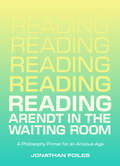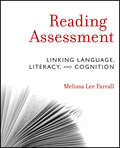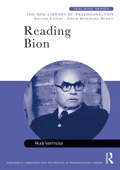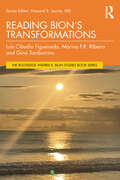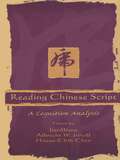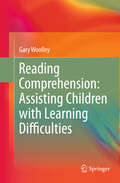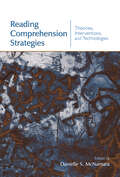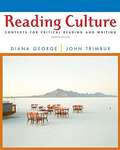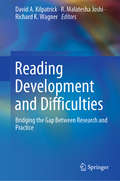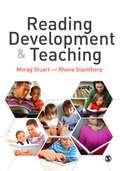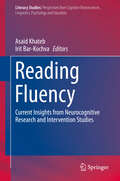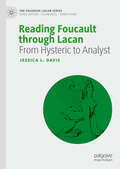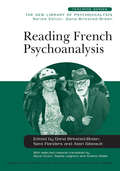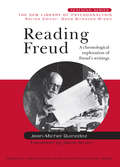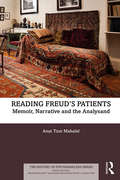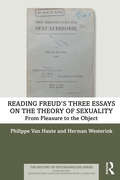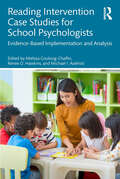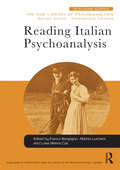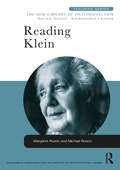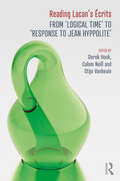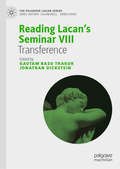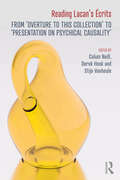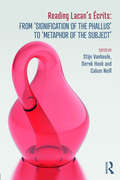- Table View
- List View
Reading Arendt in the Waiting Room: A Philosophy Primer for an Anxious Age
by Jonathan FoilesAnxiety may be the defining feeling of our current era, and though it affects many people on a deeply personal level, the last few years have also witnessed the rise of more communal feelings of dread and unknowing, problems that sometimes seem too bi
Reading Assessment
by Melissa Lee FarrallA groundbreaking integrated approach to reading assessment that addresses each child's unique Learning Profile Fifteen to twenty percent of our nation's children have reading difficulties. Educational evalua-tors must be able to use progress monitoring and diagnostic tools effectively to identify students who may be at risk, evaluate the effectiveness of school-wide reading programs, and suggest interventions that will improve reading skills. Written from a strengths-based perspective, Reading Assessment: Linking Language, Literacy, and Cognition is the first book of its kind to present a research-based, integrated review of reading, cognition, and oral language testing and assessment.Author Melissa Lee Farrall explores the theoretical underpinnings of reading, language, and literacy, explains the background of debates surrounding these topics, and provides detailed information and administration tips on the wide range of reading inventories and standardized tests that may be used in a reading psychoeducational assessment. With a focus on how to craft professional evaluation reports that illuminate a student's strengths--not just weaknesses--Reading Assessment enables school psychologists and diagnosticians, reading specialists, and special education professionals to conduct evaluations and develop effective interdisciplinary remedial recommendations and interventions.Clear, engaging, and inviting, Reading Assessment features:Case examples and practice exercisesChapter-opening reviews of each theoryStrengths, weaknesses, and potential problems of tests and their interpretationsChapter-ending review questions that foster skill development and critical thinkingComprehensive information on more than 50 different assessment testsReading Assessment is an invaluable resource that helps professionals gain the knowledge and skills to confidently interpret test results and prepare detailed and effective evaluation reports designed to meet each child's unique needs as a learner.
Reading Bion (New Library of Psychoanalysis Teaching Series)
by Rudi VermoteWilfred R. Bion is considered a ground-breaking psychoanalyst. His thinking is rooted in Freud and Klein from where it takes an original flight. Reading Bion shows the evolution of his seminal insights in psychic functioning and puts them in a wider context. Rudi Vermote integrates a chronological close reading and discussion of Bion’s texts, with a comprehensive approach of his major concepts. The book is divided in two main parts: Transformation in Knowledge: Bion’s odyssey to understand psychic processing or the mind Transformation in O: in which Bion reinterprets his former concepts from the dimension of the unknown and unknowable The running text is put against a background of biographical data and scientific, artistic and philosophical influences on his work, which are highlighted in boxes and separate chapters. Bion’s concepts are important for anyone dealing with the mind. His ideas have an ongoing deep impact on psychoanalysis, psychotherapy and psychopathology. His concepts help to understand psychic change, creativity, individual psychodynamics and small and large-group phenomena. The discovery of their value for studies on art, literature, sociology, religion, economics has just begun. Reading Bion starts from the very beginning so that it is instructive for people who are new to his work, but the close reading and background information make it a meaningful companion for experienced psychoanalysts and psychotherapists studying his work.
Reading Bion’s Transformations (The Routledge Wilfred R. Bion Studies Book Series)
by Luis Cláudio Figueiredo Marina F Ribeiro Gina TamburrinoReading Bion's Transformations is an in-depth reading of Bion’s 1965 work, Transformations, and investigates the epistemological concept of "O" introduced by Bion.Throughout the book, Bion’s conceptual and unconventional text is discussed step-by-step, with a focus on the first three and last three chapters. The epistemological references are highlighted and analysed, allowing the reader insight into how to do a deconstructive psychoanalytic reading, acknowledging that Bion raised psychoanalytical thought and practice to new levels. The authors’ reading both de-focuses and re-focuses several theoretical statutes of O discussed by Bion in 1965. Reading Bion’s Transformations is an essential read for those approaching Bion’s work for the first time, as well as those seeking to better understand his theories and the metapsychological and epistemological impact of the concept of transformation within psychoanalysis.
Reading Chinese Script: A Cognitive Analysis
by Jian Wang Hsuan-Chih Chen Albrecht W. InhoffThis volume uses unique properties of Chinese script to focus on morphological analyses during the character and word recognition process, though some of the reported work also pertains to the use of phonological information. In addition, this volume contains work on syntactic and pragmatic processes during sentence reading and three chapters that examine on-line processes. A comprehensive appraisal of cognitive processes during the reading of Chinese script that includes studies conducted by leading researchers from within and outside the mainland, this volume will be of interest to all those studying reading and visual symbol processing.
Reading Comprehension
by Gary WoolleyReading Comprehension: Assisting Children with Learning Difficulties examines the complex nature of reading comprehension. It introduces a model for classifying reading comprehension based on an expanded Simple View of Reading. Issues related to assessment, diagnosis, and remediation of reading comprehension difficulties are discussed and translated into clear recommendations to inform reading intervention design and practice. It gives an informed understanding as to why reading comprehension is difficult for some children with learning disabilities such as ADHD, autism, language difficulties and dyslexia. From leading literacy research, the book develops a deeper understanding of thinking processes that facilitate comprehension at the word, discourse, and metacognitive levels. Children will benefit from the introduction of evidence-based methods for teaching reading comprehension using structured multiple-strategy frameworks.
Reading Comprehension Strategies: Theories, Interventions, and Technologies
by Danielle S. McNamaraFirst published in 2007. Routledge is an imprint of Taylor & Francis, an informa company.
Reading Culture: Contexts for Critical Reading and Writing
by Diana George John TrimburAcclaimed for its compelling readings and provocative images,Reading Culture provides students with outstanding instruction on how to read and write critically about the culture that surrounds them.
Reading Development and Difficulties: Bridging the Gap Between Research and Practice
by R. Malatesha Joshi David A. Kilpatrick Richard K. WagnerThis book provides an overview of current research on the development of reading skills as well as practices to assist educational professionals with assessment, prevention, and intervention for students with reading difficulties. The book reviews the Componential Model of Reading (CMR) and provides assessment techniques, instructional recommendations, and application models. It pinpoints specific cognitive, psychological, and environmental deficits contributing to low reading skills, so educators can accurately identify student problems and design and implement appropriate interventions. Chapters offer methods for assessing problems in decoding, word and sound recognition, and comprehension. In addition, chapters emphasize the recognition of student individuality as readers and learners, from understanding distinctions between difficulties and disabilities to the effects of first-language orthography on second-language learning. Topics featured in this book include:Learning the structure of language at the word level.Reading comprehension and reading comprehension difficultiesAssessing reading in second language learners.Effective prevention and intervention for word-level reading difficulties.The neurobiological nature of developmental dyslexia. Reading Development and Difficulties is a must-have resource for researchers, practitioners, and graduate students in varied fields, including child and school psychology; assessment, testing, and evaluation; social work; and special education. "I think the book has the potential to be a game changer. It will certainly challenge the expectations of policy makers, not to mention the teachers of beginning readers. These chapters will enhance the knowledge base of those in our schools who are charged with the lofty task of assuring that children have the best possible opportunities to acquire the skill of reading.” Sir Jim RoseChair and author of Independent Review of the Teaching of Early Reading: Final Report (2006)
Reading Development and Teaching (Discoveries & Explanations in Child Development)
by Professor Rhona Stainthorp Morag StuartThis textbook will prove invaluable to teacher educators, teachers, educational psychologists, and any professional who is involved with teaching children to read. It provides a detailed examination of the processes that are involved in achieving fluent word reading skills and ability to comprehend written texts. Understanding these processes and their development empowers teachers to select appropriate, evidence-based teaching strategies and thus teach children more effectively. The book is in four parts: Part 1 provides the reader with a Tutorial Review covering essential knowledge about language, and presenting the two dimensions of the Simple View of Reading. Part 2 concentrates on the word reading dimension, with chapters on processes in skilled word reading, the development of these processes, and practical advice on research validated teaching methods to develop children’s word reading skills. Part 3 turns to the language comprehension dimension, with chapters on the comprehension of oral and written language, and on teaching reading comprehension. Part 4 introduces the reader to assessment practices and methods of identifying children with difficulties in either or both dimensions of the Simple View, and considers children with word reading difficulties and children with specific comprehension difficulties, describing effective evidence-based interventions for each type of difficulty.
Reading Development and Teaching (Discoveries & Explanations in Child Development)
by Morag Stuart Rhona StainthorpThis textbook will prove invaluable to teacher educators, teachers, educational psychologists, and any professional who is involved with teaching children to read. It provides a detailed examination of the processes that are involved in achieving fluent word reading skills and ability to comprehend written texts. Understanding these processes and their development empowers teachers to select appropriate, evidence-based teaching strategies and thus teach children more effectively. The book is in four parts: Part 1 provides the reader with a Tutorial Review covering essential knowledge about language, and presenting the two dimensions of the Simple View of Reading. Part 2 concentrates on the word reading dimension, with chapters on processes in skilled word reading, the development of these processes, and practical advice on research validated teaching methods to develop children’s word reading skills. Part 3 turns to the language comprehension dimension, with chapters on the comprehension of oral and written language, and on teaching reading comprehension. Part 4 introduces the reader to assessment practices and methods of identifying children with difficulties in either or both dimensions of the Simple View, and considers children with word reading difficulties and children with specific comprehension difficulties, describing effective evidence-based interventions for each type of difficulty.
Reading Fluency
by Asaid Khateb Irit Bar-KochvaThe book is dedicated to the blessed memory of Prof. Zvia Breznitz, whose groundbreaking research has made a tremendous impact on the understanding of fluency in reading. The book presents a multidimensional perspective of recent research and reviews on fluency in reading. The first part presents recent brain-imaging findings from studies into the neurobiological basis of reading, as well as cognitive and language studies exploring the underlying factors of fluency in reading and its development. The second part comprises reviews of intervention studies that address reading ability, and in particular, fluency in reading. The book provides a unique multilingual perspective on reading research by including studies of readers of different orthographies and speakers of different languages. Both scientists exploring the different aspects of reading and language, and clinicians of reading intervention will find this book not only of great interest but extremely useful in its clear and in-depth presentation of current reading research.
Reading Foucault Through Lacan: From Hysteric to Analyst (The Palgrave Lacan Series)
by Jessica L. DavisJacques Lacan and Michel Foucault are often cast as intellectual adversaries, their legacies marked by differences in method, lineages, and analytical priorities. Yet beneath their distinct projects lies a shared ambition: to decenter the Western conception of the subject while critically engaging with the notion of subjectivity in post-Kantian thought. This book examines Foucault’s critical project through the lens of Lacan’s theory of the four discourses, introduced in Seminar XVII: The Other Side of Psychoanalysis (1969-70). Divided into two parts, Reading Foucault through Lacan unfolds as a dialogue between the discourses of the Hysteric and the Analyst. Part I, “The Hysteric,” reframes Foucault’s genealogical critique from the early to mid-1970s as a form of hysterical questioning directed at Kant’s transcendental legacy and its aftermath. Through an exploration of how violence and embodied resistance interact in a discursive framework, Part I uncovers the epistemological fractures that mark the modern subject. Part II, “The Analyst,” examines Foucault’s redefinition of Kantian critique as a historically situated engagement with the present. Building on Lacan’s claim that analytic experience begins with the hystericization of discourse, this section views Foucault’s re-alignment with Kant as retroactively constituting the transformation from Hysteric to Analyst. Addressing themes such as parrhesia, transference, and the ethics of speaking, Part II examines discourse as a social link that transcends fixed identities to inhabit new modes of being. Drawing on newly available English translations of Foucault’s lectures and Lacan’s seminars, this book bridges two key trajectories in French thought and offers valuable insights for scholars of psychoanalysis, critical theory, and social philosophy.
Reading French Psychoanalysis (New Library of Psychoanalysis Teaching Series)
by David Alcorn Alain Gibeault Dana Birksted—Breen Sara Flanders Sophie Leighton Andrew WellerHow has psychoanalysis developed in France in the years since Lacan so dramatically polarized the field? In this book, Dana Birksted-Breen and Sara Flanders of the British Psychoanalytical Society, and Alain Gibeault of the Paris Psychoanalytical Society provide an overview of how French psychoanalysis has developed since Lacan. Focusing primarily on the work of psychoanalysts from the French Psychoanalytical Association and from the Paris Psychoanalytical Society, the two British psychoanalysts view the evolution of theory as it appears to them from the outside, while the French psychoanalyst explains and elaborates from inside the French psychoanalytic discourse. Seminal and representative papers have been chosen to illuminate what is special about French thinking. A substantial general introduction argues in favour of the specificity of 'French psychoanalysis', tracing its early influences and highlighting specific contemporary developments. Sections are made up of introductory material by Alain Gibeault, followed by illustrative papers in the following categories: the history of psychoanalysis in France the pioneers and their legacy the setting and the process of psychoanalysis phantasy and representation the body and the drives masculine and feminine sexuality psychosis. An excellent introduction to French psychoanalytical debate, Reading French Psychoanalysis sheds a complementary light on thinking that has evolved differently in England and North America. It will be ideal reading for beginners and advanced students of clinical theory as well as experienced psychoanalysts wanting to know more about French Psychoanalytic theory, and how it has developed.
Reading Freud: A Chronological Exploration of Freud's Writings (New Library of Psychoanalysis Teaching Series)
by Jean-Michel QuinodozWinner of the 2010 Sigourney Award! Reading Freud provides an accessible outline of the whole of Freud's work from Studies in Hysteria through to An Outline of Psycho-Analysis. It succeeds in expressing even the most complex of Freud's theories in clear and simple language whilst avoiding over-simplification. Each chapter concentrates on an individual text and includes valuable background information, relevant biographical and historical details, descriptions of Post-Freudian developments and a chronology of Freud's concepts. By putting each text into the context of Freud's life and work as a whole, Jean-Michel Quinodoz manages to produce an overview which is chronological, correlative and interactive. Texts discussed include: The Interpretation of Dreams The 'Uncanny' Civilisation and its Discontents' The clear presentation, with regular summaries of the ideas raised, encourages the reader to fully engage with the texts presented and gain a thorough understanding of each text in the context of its background and impact on the development of psychoanalysis. Drawing on his extensive experience as a clinician and a teacher of psychoanalysis, Jean-Michel Quinodoz has produced a uniquely comprehensive presentation of Freud's work which will be of great value to anyone studying Freud and Psychoanalysis.
Reading Freud’s Patients: Memoir, Narrative and the Analysand (The History of Psychoanalysis Series)
by Anat Tzur MahalelWhat would the story of analysis look like if it were told through the eyes of the analysand? How would the patient write and present the analytic experience? How would the narrative as written by the analysand differ from the analytic narrative commonly offered by the analyst? What do the actual analytic narratives written by Freud’s patients look like? This book aims to confront these intriguing questions with an innovative reading of memoirs by Freud’s patients. These patients—including Sergei Pankejeff, known as the Wolf Man; the poet H. D.; and the American psychoanalyst Abram Kardiner—all came to Vienna specially to meet Freud and embark with him on the intimate and thrilling journey of deciphering the unconscious and unravelling the secrets of the psyche. A broad psychoanalytic and literary-historical reading of their memoirs is offered in this new entry to the popular Routledge History of Psychoanalysis Series, with the purpose of presenting the analysands' narratives as they themselves recounted them. This makes it possible to re-examine the links among psychoanalysis, literature, and translation and sheds new light on the complex challenge of coming to know oneself through the encounter with otherness. This book is unique in its focus on multiple memoirs by patients of Freud and presents a fresh, even startling, close-up look at psychoanalysis as a clinical practice and as a rigorous discourse and offers a new vision of Freud’s strengths and, at times, defects. It will be of considerable interest to scholars of psychoanalysis and intellectual history, as well as those with a wider interest in literature and memoir.
Reading Freud’s Three Essays on the Theory of Sexuality: From Pleasure to the Object (The History of Psychoanalysis Series)
by Herman Westerink Philippe Van HauteSigmund Freud’s 1905 Three Essays on the Theory of Sexuality is a founding text of psychoanalysis and yet it remains to a large extent an "unknown" text. In this book Freud’s 1905 theory of sexuality is reconstructed in its historical context, its systematic outline, and its actual relevance. This reconstruction reveals a non-oedipal theory of sexuality defined in terms of autoerotic, non-objectal, physical-pleasurable activities originating from the "drive" and the excitability of erogenous zones. This book, consequently, not only calls for a reconsideration of the development of Freudian thinking and of the status of the Oedipus complex in psychoanalysis but also has a strong potential for supporting contemporary non-heteronormative theories of sexuality. It is as such that the 1905 edition of Three Essays becomes a highly relevant document in contemporary philosophical discussions of sexuality. This book also explores the inconsistencies and problems in the original theory of sexuality, notably the unresolved question of the transition from autoerotic infantile sexuality to objectal adult sexuality, as well as the theoretical and methodological shifts present in later editions of Three Essays. It will be of great interest to psychoanalysts and those with an academic interest in the history of psychoanalysis and sexuality.
Reading Intervention Case Studies for School Psychologists: Evidence-Based Implementation and Analysis
by Michael I. Axelrod Melissa Coolong-Chaffin Renee O. HawkinsReading Intervention Case Studies for School Psychologists provides vivid, real-world examples of school-based interventions targeting students’ phonological awareness, phonics, fluency, and comprehension in reading. This book offers a rich variety of applied reading interventions in school settings , spanning strategies such as incidental teaching, word boxes, peer tutoring, taped words, story mapping, and beyond. Each case includes thorough descriptions of the specific area of concern, detailed intervention protocols, data collection and analysis methods, and tips for ensuring social acceptability and treatment integrity. School psychologists, along with related professionals in special education, general education, and speech-language pathology, will come away with new insights into this comprehensive set of well-researched and frequently applied reading interventions.
Reading Italian Psychoanalysis (New Library of Psychoanalysis Teaching Series)
by Franco Borgogno Alberto Luchetti Luisa Marino CoeWinner of the American Board & Academy of Psychoanalysis Prize for best Edited book published in 2016 Psychoanalysis in Italy is a particularly diverse and vibrant profession, embracing a number of influences and schools of thought, connecting together new thinking, and producing theorists and clinicians of global renown. Reading Italian Psychoanalysis provides a comprehensive guide to the most important Italian psychoanalytic thinking of recent years, including work by major names such as Weiss, E.Gaddini, Matte Blanco, Nissim Momigliano, Canestri, Amati Mehler, and Ferro. It covers the most important theoretical developments and clinical advances, with special emphasis on contemporary topics such as transference, trauma and primitive states of mind where Italian work has been particular influential. In this volume, Franco Borgogno, Alberto Luchetti and Luisa Marino Coe of the Italian Psychoanalytical Society provide an overview of how Italian psychoanalysis has developed from the 1920’s to the present day, tracing its early influences and highlighting contemporary developments. Forty-six seminal and representative papers of psychoanalysts belonging to the two Italian psychoanalytical societies (the Italian Psychoanalytical Society and the Italian Association of Psychoanalysis) have been chosen to illuminate what is special about Italian theoretical and clinical thinking, and what is demonstrative of the specificity of its psychoanalytic discourse. The selected papers are preceded by a first introductory section about the history of psychoanalysis in Italy and followed by a "swift glance at Italian psychoanalysis from abroad". They are grouped into sections which represent the areas particularly explored by Italian psychoanalysis. Each section is accompanied by introductory comments which summarize the main ideas and concepts and also their historical and cultural background, so as to offer to the reader either an orientation and stimulus for the debate and to indicate their connections to other papers included in the present volume and to the international psychoanalytic world. The book is divided into six parts including: History of psychoanalysis in Italy Metapsychology Clinical practice, theory of technique, therapeutic factors The person of the analyst, countertransference and the analytic relationship/field Trauma, psychic pain, mourning and working-through Preverbal, precocious, fusional, primitive states of the mind This volume offers an excellent and detailed "fresco" of Italian psychoanalytic debate, shining a light on thinking that has evolved differently in France, England, North and Latin America. It is an ideal book for beginners and advanced students of clinical theory as well as experienced psychoanalysts wanting to know more about Italian psychoanalytic theory and technique, and how they have developed.
Reading Klein (New Library of Psychoanalysis Teaching Series)
by Michael Rustin Margaret RustinReading Klein provides an introduction to the work of one of the twentieth century’s greatest psychoanalysts, known in particular for her contribution in developing child analysis and for her vivid depiction of the inner world. This book makes Melanie Klein’s works highly accessible, providing both substantial extracts from her writings, and commentaries by the authors exploring their significance. Each chapter corresponds to a major field of Klein’s work outlining its development over almost 40 years. The first part is concerned with her theoretical and clinical contributions. It shows Klein to be a sensitive clinician deeply concerned for her patients, and with a remarkable capacity to understand their unconscious anxieties and to revise our understanding of the mind. The second part sets out the contribution of her ideas to morality, to aesthetics and to the understanding of society, introducing writing by her associates as well as herself. The book provides a lucid account of Klein’s published writing, presented by two distinguished writers who know her work well and have made creative use of it in their own clinical and extra-clinical writing. Its aim is to show how substantial her contribution to psychoanalytic thinking and clinical practice was, and how indispensable it remains to understanding the field of psychoanalysis. Reading Klein will be a highly valuable resource for students, trainees in psychoanalysis, psychoanalytic practitioners and all who are interested in Melanie Klein and her legacy.
Reading Lacan's Écrits: From ‘Logical Time’ to ‘Response to Jean Hyppolite’
by Derek HookReading Lacan’s Écrits is the first extensive set of commentaries on the complete edition of Lacan’s Écrits to be published in English. This third volume provides an indispensable companion piece to some of Lacan’s most crucial and notoriously challenging writings, from ‘Logical Time’ to ‘Response to Jean Hyppolite’, and including ‘The Function and Field of Speech’, ‘Variations on the Standard Treatment’ and ‘Presentation on Transference’. With the contributions of some of the world’s most renowned Lacanian scholars and analysts – such as Bernard Burgoyne, Marc De Kesel and Russell Grigg – this volume encompasses a series of systematic, paragraph-by-paragraph commentaries which not only contextualize, explain and interrogate Lacan’s arguments, but afford the reader multiple interpretive routes through the complete edition of Lacan’s most labyrinthine of texts. As there is no existing set of exhaustive commentaries on Lacan’s Écrits available in English, this volume acts as an essential and incisive reference-text for psychoanalysts and psychoanalytic psychotherapists in training and in practice, as well as philosophers, cultural theorists and literary, social science and humanities researchers. Considering the significance of Écrits as a landmark in the history of psychoanalysis, this far-reaching and accessible guide will sustain and continue to animate critical engagement with one of the most challenging intellectual works of the twentieth century.
Reading Lacan's Écrits: From ‘The Freudian Thing’ to 'Remarks on Daniel Lagache'
by Derek Hook Calum Neill Stijn VanheuleThe Écrits was Jacques Lacan’s single most important text, a landmark in psychoanalysis which epitomized his aim of returning to Freud via structural linguistics, philosophy and literature. Reading Lacan’s Écrits is the first extensive set of commentaries on the complete edition of Lacan’s Écrits to be published in English. An invaluable document in the history of psychoanalysis, and one of the most challenging intellectual works of the 20th Century, Lacan’s Écrits still today begs the interpretative engagement of clinicians, scholars, philosophers and cultural theorists. The three volumes of Reading Lacan’s Écrits offer just this: a series of systematic paragraph-by-paragraph commentaries – by some of the world’s most renowned Lacanian analysts and scholars – on the complete edition of the Écrits, inclusive of lesser known articles such as ‘Kant with Sade’, ‘The Youth of Gide’, ‘Science and Truth’, ‘Presentation on Transference’ and ‘Beyond the "Reality Principle"'. The originality and importance of Lacan’s Écrits to psychoanalysis and intellectual history is matched only by the text’s notorious inaccessibility. Reading Lacan’s Écrits is an indispensable companion piece and reference-text for clinicians and scholars exploring Lacan's magnum opus. Not only does it contextualize, explain and interrogate Lacan's arguments, it provides multiple interpretative routes through this most labyrinthine of texts. Reading Lacan’s Écrits provides an incisive and accessible companion for psychoanalysts and psychoanalytic psychotherapists in training and in practice, as well as philosophers, cultural theorists and literary, social science and humanities researchers who wish to draw upon Lacan’s pivotal work.
Reading Lacan’s Seminar VIII: Transference (The Palgrave Lacan Series)
by Gautam Basu Thakur Jonathan DicksteinThis book provides 18 lively commentaries on Lacan’s Seminar VIII, Transference (1960-61) that explore its theoretical and philosophical consequences in the clinic, the classroom, and society. Including contributions from clinicians as well as scholars working in philosophy, literature, and culture studies, the commentaries presented here represent a wide-range of disciplinary perspectives on the concept of transference. Some chapters closely follow the structure of the seminar’s sessions, while others take up thematic concerns or related sessions such as the commentary on sessions 19 to 22 which deal with Lacan’s discussion of Claudel’s Coûfontaine trilogy. This book is not a compendium to Lacan’s seminar. Instead it attempts to capture through shorter contributions a spectrum of voices debating, deliberating, and learning with Lacan’s concept. In doing so it can be seen to engage with transference conceptually in a manner that matches the spirit of Lacan’s seminar itself.The book will provide an invaluable new resource for Lacan scholars working across the fields of psychoanalytic theory, clinical psychology, philosophy and cultural studies.
Reading Lacan’s Écrits: From ‘Overture to this Collection’ to ‘Presentation on Psychical Causality’
by Calum Neill, Derek Hook and Stijn VanheuleReading Lacan's Écrits is the first extensive set of commentaries on the complete edition of Lacan's Écrits to be published in English, providing an indispensable companion piece to some of Lacan's best-known but notoriously challenging writings.With the contributions of some of the world's most renowned Lacanian scholars and analysts, Reading Lacan's Écrits encompasses a series of systematic, paragraph-by-paragraph commentaries that not only contextualise, explain and interrogate Lacan's arguments but also afford the reader multiple interpretive routes through the complete edition of Lacan's most labyrinthine of texts. Considering the significance of Écrits as a landmark in the history of psychoanalysis, this far-reaching and accessible guide will sustain and continue to animate critical engagement with one of the most challenging intellectual works of the twentieth century.These volumes act as an essential and incisive reference-text for psychoanalysts and psychoanalytic psychotherapists in training and in practice, as well as philosophers, cultural theorists and literary, social science and humanities researchers. This volume covers the first two sections of the Écrits, providing close readings of the first eight essays.
Reading Lacan’s Écrits: From ‘Signification of the Phallus’ to ‘Metaphor of the Subject’
by Derek Hook Calum Neill Stijn VanheuleThe Écrits was Jacques Lacan’s single most important text, a landmark in psychoanalysis which epitomized his aim of returning to Freud via structural linguistics, philosophy and literature. Reading Lacan’s Écrits is the first extensive set of commentaries on the complete edition of Lacan’s Écrits to be published in English. An invaluable document in the history of psychoanalysis, and one of the most challenging intellectual works of the twentieth century, Lacan’s Écrits still today begs the interpretative engagement of clinicians, scholars, philosophers and cultural theorists. The three volumes of Reading Lacan’s Écrits offer just this: a series of systematic paragraph-by-paragraph commentaries – by some of the world’s most renowned Lacanian analysts and scholars – on the complete edition of the Écrits, inclusive of lesser known articles such as ‘Kant with Sade’, ‘The Youth of Gide’, ‘Science and Truth’, ‘Presentation on Transference’ and ‘Beyond the "Reality Principle". The originality and importance of Lacan’s Écrits to psychoanalysis and intellectual history is matched only by the text’s notorious inaccessibility. Reading Lacan’s Écrits is an indispensable companion piece and reference-text for clinicians and scholars exploring Lacan's magnum opus. Not only does it contextualize, explain and interrogate Lacan's arguments, it provides multiple interpretative routes through this most labyrinthine of texts. Reading Lacan’s Écrits provides an incisive and accessible companion for psychoanalysts and psychoanalytic psychotherapists in training and in practice, as well as philosophers, cultural theorists and literary, social science and humanities researchers who wish to draw upon Lacan’s pivotal work.
